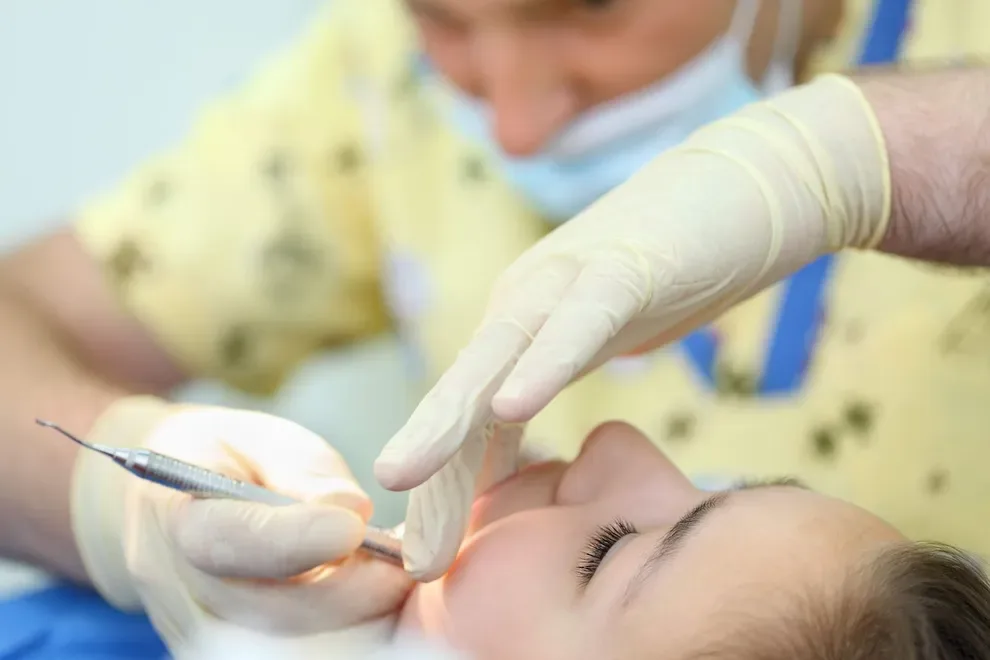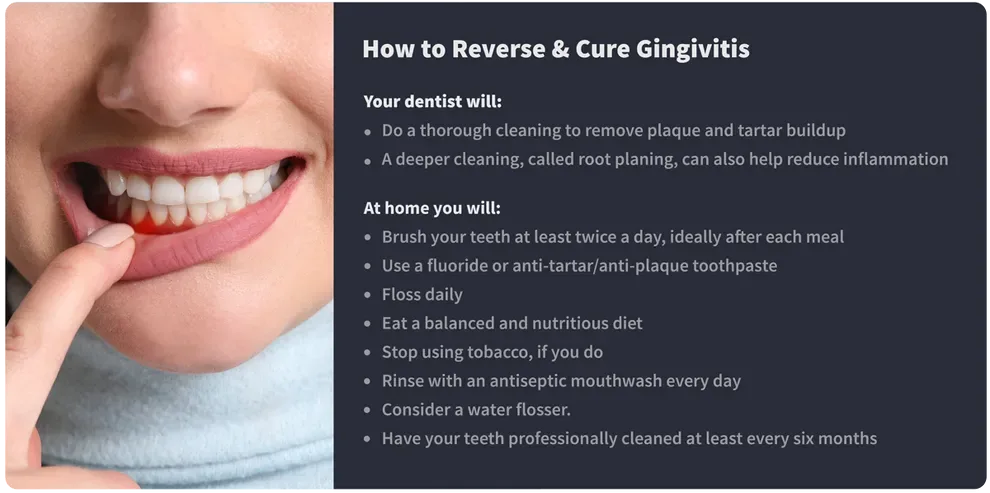Gingivitis Treatment: Can You Permanently Cure Gingivitis?

Table of Contents
- Reversing Gingivitis
- Gingivitis Prevention
- Ongoing Care at Home
- References
If you catch it before it becomes periodontal disease, gingivitis can often be completely reversed. Keep up with good dental hygiene and gingivitis can be cured, so it does not come back.
Treatment for gingivitis starts at the dentist office with a professional teeth cleaning that uses specialized tools to remove the plaque from your teeth. Tartar buildup on your teeth can only be completely removed by a dental professional.
After dental professionals remove the plaque from your teeth, if you keep up with good dental hygiene such as regular brushing and flossing, gingivitis can usually clear up in a few weeks. With continuing care, it can be permanently cured.
Reversing Gingivitis

Gum disease is a serious condition that impacts nearly half of all adults in the United States over the age of 30.
It can cause you to lose teeth by breaking down tissue and bone that supports them. This happens when tartar, which can stick to the teeth after eating, builds up and hardens, eventually causing the gums to pull away from the teeth.
Plaque can build up on your teeth and cause the gums to become inflamed. This is gingivitis.
Gingivitis is the earliest stage of gum disease, and it is frequently completely reversible. If your gums are red and swollen, you may have early-stage gingivitis. The earlier you treat it, the better the long-term outcome. The first step is to see a dental professional.
In a healthy mouth, the gum's pocket depth should be between 1 and 3 millimeters, and gum pockets that are deeper than 4 millimeters may be signs of gum disease.
Gingivitis Prevention
While gum disease is common and the earliest stages are reversible, many people can avoid gingivitis and gum problems altogether by taking proactive steps.
The best defense you have against gingivitis and gum disease is an effective daily hygiene routine. This should include brushing your teeth twice daily, flossing once a day, and using an antimicrobial mouthwash.
Tips for a Gum-Healthy Daily Dental Routine
Consistency is key! Making dental care a must-do every single morning and night will make all the difference in your oral health and smile. Remember how little time your overall routine takes and the huge difference it will make for the health of your mouth.
Choose dental products you enjoy. Get excited about your routine with tools and tooth products you enjoy. Choose a toothpaste flavor you like, a toothbrush you find comfortable, and other products (like whitening or eco-friendly choices) that you feel good about.
Be mindful. When brushing, be sure you’re taking your time and getting all sides of every tooth. Be sure to angle the toothbrush so you’re getting the area where the gums meet the teeth. When flossing, make sure to get close to the gum line and find all those hard-to-reach places.
Keep it gentle. Getting too aggressive with brushing or flossing can irritate gums and create inflammation, which is what you want to avoid. Use a toothbrush with soft bristles and take care with the gums when flossing.
If you’re keeping up on your dental visits, it’s harder for an oral care problem, like gum inflammation, to spiral out of control or worsen dramatically. During your visits, your dentist and hygienist will see any potential problems and devise a treatment plan to address them.
Regular cleanings will also help to prevent bacteria buildup on the gums and gum-irritating decay and plaque.
If you’re in between dental appointments but notice gum symptoms like bleeding, puffiness, or unusual irritation, call your dentist about your concerns. They may want to see you sooner, or set up a virtual examination.
Eating a healthful diet can lower the risk of gum disease.
Avoid sugary, sweet snacks. Sugar leads to bacteria and decay.
Stay away from starchy snacks. Potato chips and other crunchy carbs may get stuck to teeth and in the area between your gums and teeth.
Eat more veggies. Not only do many vegetables contain enamel-fortifying minerals and vitamins, but they also help in the production of saliva, which helps to wash away bacteria and plaque.
Include dairy. Cheese, milk, and yogurt are calcium-rich, and they also produce saliva. Yogurt contains bacteria-fighting probiotics.
Drink water. Water washes away food particles and bacteria.
Smokers are at much higher risk of developing gum disease. Smoking may reduce the amount of oxygen in the blood, which could make it harder for gums to heal or recover from infection or inflammation.
Quitting smoking greatly reduces your risk for gingivitis. You can find more resources for quitting smoking at smokefree.gov.
Gingivitis needs to be diagnosed by a dental professional and initially treated at a dental office. The dentist and dental hygienist will do a thorough cleaning to remove plaque and tartar buildup on your teeth. They will also examine your teeth for any irregularities or other issues.
When the plaque is calcified on the teeth, dental professionals will use specialized tools to scale your teeth. One of these tools is manual and looks like a hook. It can be used to scale the tartar from the surface of your teeth up under your gum line. An ultrasonic scaling device can also help to break up these particles.
A deeper cleaning, called root planing, can reduce the inflammation in your gums by smoothing out root surfaces. This can allow your gums to heal and better reattach to your teeth. A deep cleaning of your teeth by dental professionals can help to treat, reverse, and cure gingivitis.
Ongoing Care at Home
To permanently reverse and cure gingivitis, you will need to keep up with good oral hygiene, which includes the following steps:
Brush your teeth at least twice a day, ideally after each meal.
Use a fluoride or anti-tartar/anti-plaque toothpaste.
Floss daily.
Eat a balanced and nutritious diet.
Stop using tobacco if you do.
Rinse with an antiseptic mouthwash every day.
Consider a water flosser to remove food debris from in between your teeth and under your gums.
Have your teeth professionally cleaned at least every six months.
If you are especially prone to gingivitis, you may need more frequent professional cleanings. Infections, pregnancy, illness, and the use of certain medications can increase your risk for gingivitis. This means you may need additional cleanings and more intensive at-home care to keep tartar at bay.
A dental professional can show you how to brush and floss your teeth properly. Inquire about this at your next visit.
Maintaining good oral hygiene can help to prevent gingivitis in the first place and keep it from recurring. Remember that in its early stages, gingivitis can usually be completely reversed and even cured. With continued vigilance, it won’t return.
